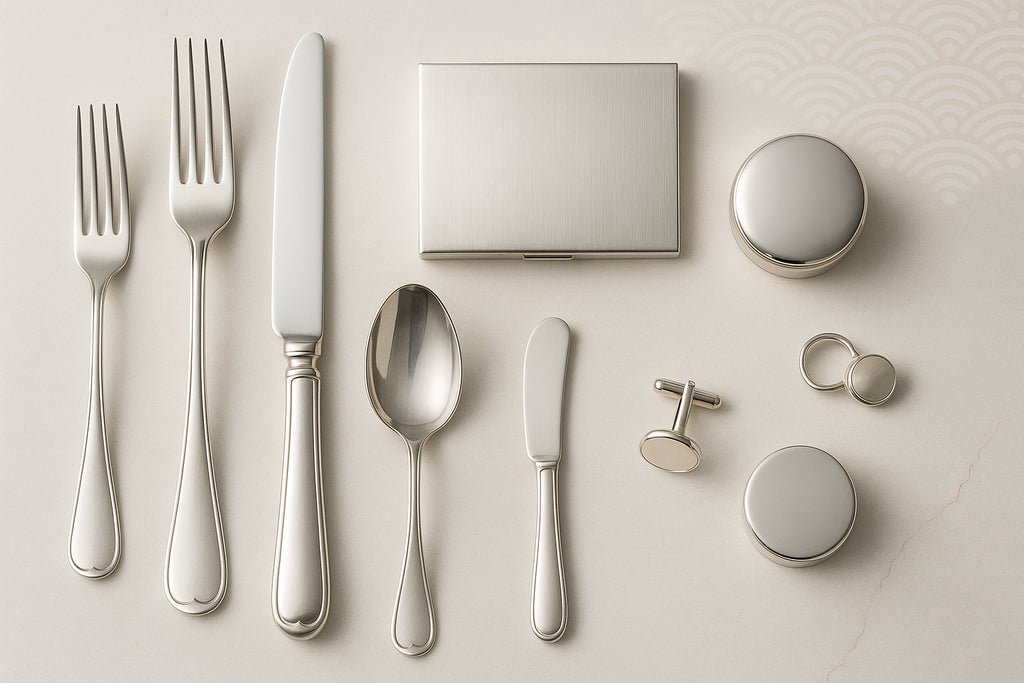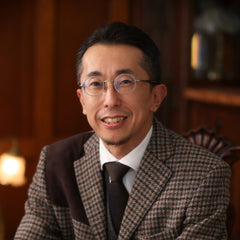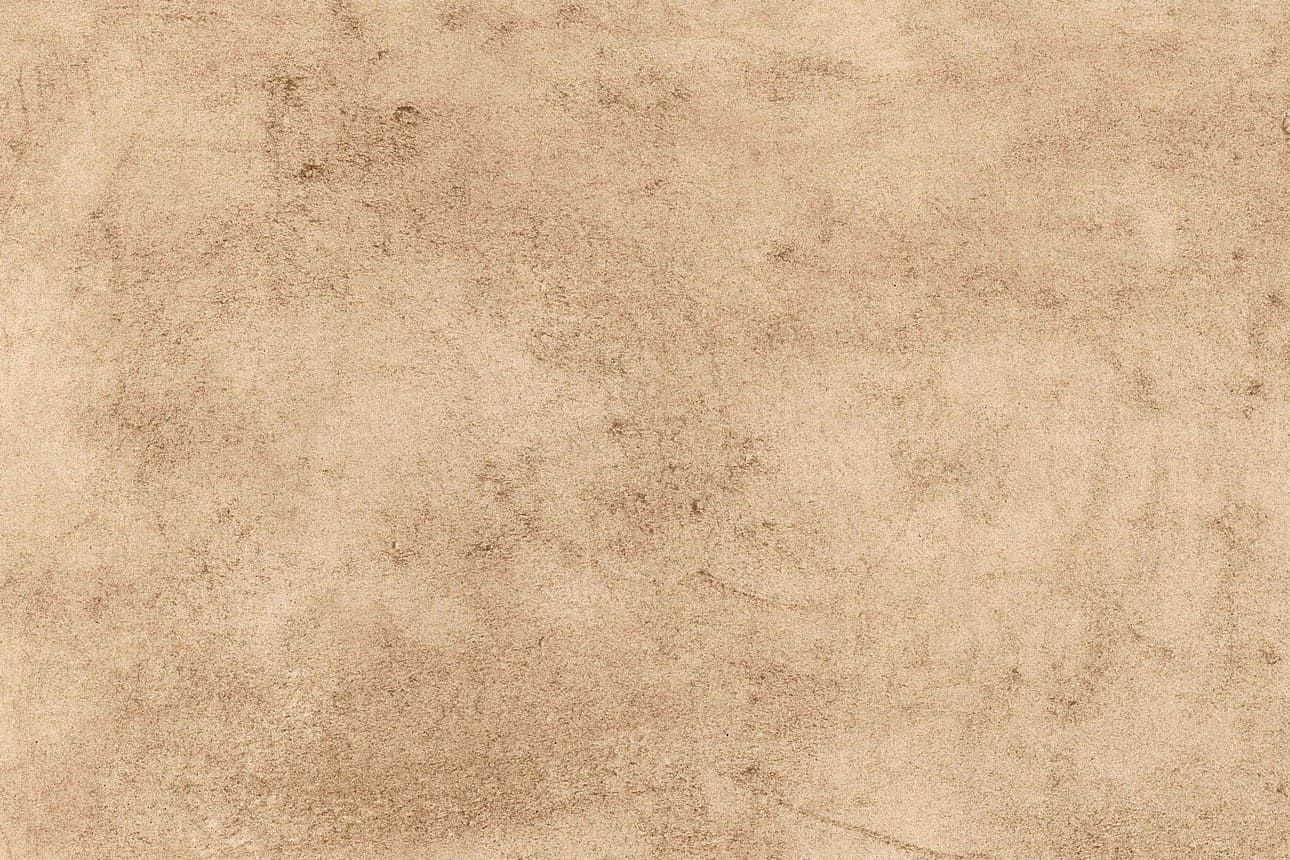Why Sterling Silver is Described as Pure Silver in Japan
Posted by WATANABETAIGA

When dealing in Western antique silver products, I occasionally receive questions from customers.
"The product description says 'pure silver,' but the stamp says it's sterling silver, right? Why do you call it pure silver?"
This is a natural question for anyone with even a little knowledge of silver purity.
Chemically speaking, pure silver refers to silver with a purity of 99.9% or more (SV999), while sterling silver is an alloy with a silver content of 92.5% (SV925).
However, the use of the term "pure silver" in the Japanese antiques industry is not simply a misnomer; there is a deeper reason for it, rooted in centuries of Western history and the cultural context in which it has been adopted in Japan.
In this article, we will explain why we sometimes refer to sterling silver as "pure silver," exploring the meaning and history of the term.
1. The Meaning of Each Word in English and the Origin of the Word "Sterling"
First, to avoid confusion, let's clarify some basic definitions.
When discussing silver products, the following terms are commonly used in English-speaking countries. Each has a slightly different meaning.
Fine Silver / Pure Silver
This refers to "pure silver" in the chemical sense. It refers to silver with a silver content of 99.9% or more (999/1000).
Its lustrous white shine is beautiful, but it is very soft and easily bent or damaged with even slight force.
For this reason, it is rarely used as a material for everyday products such as tableware, and is primarily used for bullion and commemorative coins.
Sterling Silver
This is an alloy containing 92.5% silver (925/1000), with the remaining 7.5% being made up of metals such as copper (alloys).
The addition of alloys increases the practical strength and durability of pure silver without impairing its beautiful luster.
This exquisite blend ratio has become the global standard for Western (especially British) silver products.
Solid Silver
This term translates to "pure silver" and means "made entirely of silver alloy, from the inside out."
This term distinguishes it from "silver-plated" silver, which is silver applied only on the surface, and does not refer to a specific purity.
Therefore, both sterling silver (92.5%) and the 80.0% silver used in continental Europe are included in the term "solid silver."
Silver Plate
This refers to "silver-plated" products. A very thin layer of silver is coated on the surface of a base such as copper or nickel.
You can enjoy the shine of silver at an affordable price, but over time the plating may peel off, revealing the base metal.
It is distinguished by a stamp such as EPNS (Electro Plated Nickel Silver).
For more information on silver types and purity, please see this blog post.
[Blog Post] Silver Types (Purity, etc.)
Origin of the Term "Sterling Silver"
The most likely theory is that it originates from the "Norman Penny," a silver coin minted in Norman England around the 11th century.
This coin had a small star (called a steorling in Old English) engraved on it as a sign of its quality.
This "starred coin" was called "sterling," and the term eventually came to refer to the coin's purity, which is 92.5% silver.
Another theory is that silver coins were brought to England by North German merchants known as "Easterlings" who operated along the Baltic Sea coast during the Middle Ages.
These coins were so highly reliable that they were called "Easterling Silver," which was then shortened to "Sterling."
While it's unclear which theory is correct, what both theories agree on is that the word "sterling" strongly connoted "trustworthy, quality-guaranteed silver."
The word wasn't simply the name of an alloy, but a symbol of value.
This connotation later became absolute with the introduction of strict national quality assurance systems such as hallmarks.
2. Silver Purity in Japan
As the "sterling" standard was established in Europe and the United States, how was silver purity handled in Japan?
To conclude, from the Middle Ages to the early modern period, unified purity standards established by the government existed in Japan, but in a form that differed from that in the West.
From the Kamakura period to the Sengoku period, silver was primarily traded as bullion, traded by weight.
Silver produced at Iwami Ginzan and other places was refined using a refining technique called "cupellation" and sold on the market as "cupellation silver."
However, its purity was not consistent, and the quality was checked by appearance and touchstone testing at each transaction, and its value was determined by agreement between the parties involved.
There was no objective guarantee by the state.
This situation changed dramatically during the Edo period. To unify the monetary system, the Tokugawa shogunate established the "ginza," a place specializing in the minting and quality control of silver coins. This created "weight-based coins" such as "chogin" and "mameitagin," which were used by measuring their weight.
The ginza stamped a mark called a "gokuin" on the surface of the minted chogin. Typical examples include the design of Daikoku-sama and the character "treasure." These markings were a unique Japanese guarantee of quality, certifying that the silver coin met the shogunate's standards.
This function can be considered similar to the Western hallmark system.

However, there was one crucial difference from Western sterling silver.
That is, the purity was not consistent.
For example, in the early Edo period, the silver purity of Keicho-chogin was set at approximately 80%.
However, when financial difficulties arose, the shogunate frequently reminted new silver coins with a lower silver content in order to make profits.
During the Genroku period, the purity was around 64%, and later, silver coins with purity levels below 50% appeared.
In other words, Japan's silver system was constantly subject to change.
Its fundamental philosophy differed from that of sterling silver, which had long been fixed as an absolute standard.
3. Why Sterling Silver is Referred to as "Jungin" in Japan
Now, with this background in mind, we can finally move on to the main topic.
Why did the practice of referring to 92.5% pure sterling silver as "Jungin" arise in Japan?
This is the result of placing more importance on "historically guaranteed value" than "chemical purity," and stems from the way Japanese people interpreted Western culture when they adopted it during the Meiji period.
The story dates back to 14th century England.
In 1300, King Edward I of England enacted a law prohibiting the sale of silver products unless they met the standard of sterling (92.5%).
A specialized institution (the Asay Office) then established a system in which purity was inspected and only products that passed the inspection were hallmarked.
This lion passant (walking lion) mark became the world's most trusted mark of quality, nationally certifying that the silver product is "sterling silver."
For more information on British hallmarks, please see this blog post.
[Blog Post] Hallmarks for British Silver Products
Under this system, sterling silver was the "legally recognized highest quality silver" for practical silver products.
Fine silver, which is too soft, was almost nonexistent on the market, and for people, "real, valuable silver" meant undoubtedly sterling silver.
It was not just an alloy, but a special entity whose value was guaranteed by national authority.
Fast forward to the Meiji era in Japan. Western culture and products flooded the country like a floodgates had burst.
For hundreds of years, the hallmarks shone brightly, a symbol of absolute authenticity, a guarantee of quality guaranteed by the state without change in purity.
In contrast to Japanese silver coins, whose purity fluctuated over the years, their value remained constant.
When faced with the need to translate the concept of "Sterling Silver" into Japanese, people at the time likely searched for a word that would most accurately express its value.
Simply translating it as "an alloy of 92.5% silver" would lose the underlying sense of authority and reliability, as well as the connotation of "the highest quality practical silver."
The term chosen was likely "pure silver."
At that time in Japan, silver products that ordinary people came into contact with on a daily basis were still rare, and the word "pure" intuitively conveyed high value, such as "pure" or "genuine."
It is likely that the term "pure silver" was deemed most appropriate to convey the nuance of "this is genuine, value-guaranteed silver in the Western sense," rather than its chemical accuracy.
This interpretation has since become deeply rooted as a custom in Japan's antique and jewelry industries.
Dealers and collectors have referred to hallmarked sterling silver as "pure silver" to indicate that the product is genuine, unplated, and of genuine value backed by history and trust.
Summary
When we refer to antique sterling silver products as "pure silver," we are not ignoring the chemical definition.
This is because we respect the historical significance of the term and the cultural customs that have been passed down in the industry.
The term "pure silver" ("sterling silver") has many layers of meaning:
- The history of sterling silver in Europe and the United States as a nationally certified silver product of the highest quality for practical use.
- The interpretation of sterling silver when Meiji-era Japanese people understood its absolute value and accepted it as "genuine silver."
- A cultural term that has continued to be used by the antiques industry out of respect for its historical value.
At our store, we use the term "Pure Silver" in the titles of sterling silver products. However, to avoid misunderstandings, we state the material in the "Details" section of the product description as "Material: Sterling Silver (925/1000)."
The hallmark engraved on antique silver products is more than just an indication of purity.
It is a "proof of trust" that has remained unshakable for hundreds of years.
If you look at the piece before you and think about the story behind why our ancestors respectfully called this sterling silver "pure silver," you will surely appreciate the allure of antique silver even more deeply.











